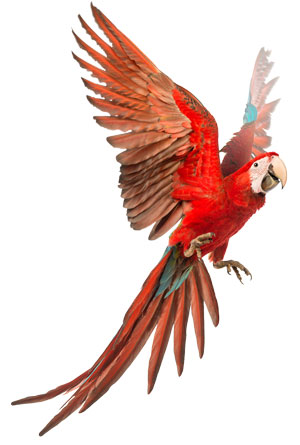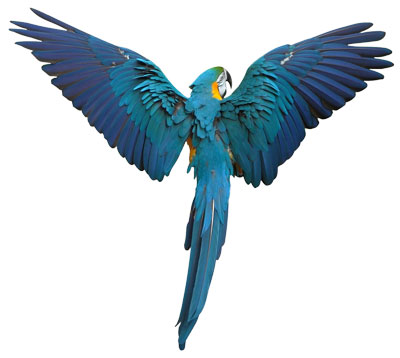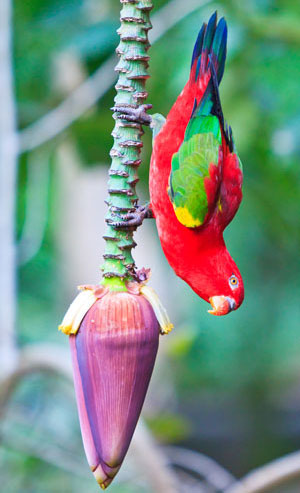Parrot puzzle
Where are the missing relatives?

The parrot family is one big family, say biologists.1 Well, technically an order, the Order Psittaciformes, comprising over 80 recognized genera and hundreds of different species, from the kea to the cockatoo, parakeet and lory, macaw and budgerigar, lorikeet and kakapo, bluebonnet, conure, cockatiel, corella, rosella, hanging parrot, king parrot, singing parrot, pygmy parrot, guaiabero, racquet-tailed parrot, lovebird and parrotlet. Their shared distinctive characteristics, such as stocky bodies (with relatively large heads on short necks), strongly curved bills, ceres (waxy2 structures surrounding the nares (nostrils) at the base of the bill), and zygodactyl feet (two toes forward and two backwards), the parrots are readily distinguishable from all other orders of birds.
Evolutionists have a problem, however. They can’t find the parrot’s closest relative. Sure, there have been plenty of suggestions over the years, citing as evidence one or a few shared physical characteristics. E.g. the owl, falcon, or hawk (because of their having curved bills); the woodpecker, cuckoo, or mousebird (zygodactyl feet); the canary (vocal learning); and the pigeon (fleshy ceres and frugivory (fruit-eating)). But as the arguments for or against these and other candidates for the parrot’s closest relative have raged, and biologists turned to new tools such as molecular and genetic studies, more “contradictory results” were reported, generating further confusion.1 In the words of one research team that had included representatives of all the nominated ‘closest relative’ bird orders in their molecular analysis of parrot genetic data:
“Our various phylogenies produced no consistent placement of outgroups as sister to the parrots, reinforcing the idea that they have no close sister relationship with modern birds.”3

And:
“The identity of their closest relative remains a mystery awaiting further investigation.”1
Why should this be such a mystery? It’s all to do with their assumptions that there should even be a ‘close relative’. This statement reveals the researchers’ evolutionary presuppositions:
“This continuing confusion suggests that parrots are indeed a very ancient order of birds that split from the ancestors of other modern birds a very long time ago, perhaps as long as 80–90 million years ago during the Cretaceous Period.”1
Now, how can anyone know what happened and when, before they were around to observe it? Ultimately, the only way of definitively knowing is by eyewitness account.4 The eyewitness account we have in God’s Word says that our Creator made all kinds of birds on Day 5 of Creation Week (Genesis 1:20–21), only about 6,000 years ago,5 to reproduce “after their kind”. As Creation magazine has pointed out many times,6 the biblical ‘kind’ does not equate to ‘species’—rather, if two modern species can hybridize, then both are descended from the same original kind.
In the case of parrots, given the widespread extent of hybridization known to occur within the order,7 the biblical ‘kind’ likely includes the entire order Psittaciformes. So when evolutionists say that parrots had a common ancestor, they’re actually right, but when they presume that the parrot and the dove (or some other non-parrot) had a common ancestor, they’re wrong. No wonder that biologists can find plenty of evidence linking all the parrots, but not beyond, i.e. to non-parrots.
The parrot’s ‘closest non-parrot relative’ is in fact missing, because it never existed!
Don’t parrot the evolutionary line

The biological evidence is that parrots have given rise to parrots—no evolution there! The order Psittaciformes is in reality an example of post-Flood adaptation and speciation (which as we’ve pointed out many times, are not evolution8).
Only about 4,500 years ago, Noah on the Ark only needed two parrots, a male and a female,9 for us today to enjoy the spectacular sight and sound of multitudes of diverse, colourful, squawking parrots in their natural habitat, across the warmer regions of the northern and southern hemispheres of the globe.
Despite the common refrain in evolutionary literature that the species of the Psittaciformes ‘evolved’ from their common parrot ancestor, there was nothing happening of the kind needed to support the evolutionary claim that bacteria became budgerigars and biologists over billions of years.
Diversification of parrots, as when mongrel dogs gave rise to new breeds, does not require any new genetic information to arise. It involves the new varieties or species carrying less variability than the ancestral group.10 Each species within the Psittaciformes is carrying a subset of the genes of Noah’s parrot pair, which in turn were descended from the original parrots created by Day 5 of Creation Week, about 6,000 years ago.
Other parrot puzzles for evolutionists

Parrots are well known for their ability to mimic human speech, but research has shown that parrots are not always merely ‘parroting’, in ‘parrot fashion’, what they hear. Rather they have demonstrated quite an impressive intelligence in being able to correctly answer simple questions, e.g. about numbers, colours and shapes.11
This ability of parrots, and documented examples of high intelligence in crows and other birds, highlights a problem for evolution. If chimpanzees, not birds, are ‘our close evolutionary cousins’, how is it that parrots and other birds can surpass chimps in various measures of intelligence?12
Also, parrots are unique among birds in using a set of pigments known as psittacofulvins to produce their rainbow of plumage colours.13,14 But how did such complex and novel biochemistry, found nowhere else in the world, come into existence? Supposed step-by-step evolution can’t even ‘get to first base’ in constructing even one enzyme necessary to code for the machinery needed to produce the suite of psittacofulvin pigments.
Rather, as the Apostle John recorded (Revelation 4:11), “Worthy are you, our Lord and God, to receive glory and honour and power, for you created all things, and by your will they existed and were created.”
References and notes
- Wright, T. and Schirtzinger, E., All in the family: The parrot family tree, PsittaScene (magazine of the World Parrot Trust) 21(2):8–11, May 2009; psittascene.org. Return to text.
- From Latin cera, wax. Return to text.
- Wright, T., Schirtzinger, E., and 9 others, A multilocus molecular phylogeny of the parrots (Psittaciformes): Support for a Gondwanan origin during the Cretaceous, Mol. Biol. Evol. 25(10):2141–2156, 2008. Return to text.
- Deuteronomy 19:15; Job 38:4,21; 2 Corinthians 13:1. Return to text.
- Cosner, L., How does the Bible teach 6,000 years? Creation 35(1):54–55, 2013; creation.com/6000-years. Return to text.
- E.g. Batten, D., Ligers and wholphins—what next? Creation 22(3):28–33, 2000; creation.com/ligers. Return to text.
- For example, offspring are reported to have resulted from the matings of parrots as different as lovebirds and budgerigars, galahs and cockatiels, cockatiels and blue-winged parrots, parakeets and princess parrots. Return to text.
- E.g. see Catchpoole, D., The 3 Rs of evolution: Rearrange, Remove, Ruin—in other words, no evolution!, Creation 35(2):47–49, 2013; creation.com/3rs. Return to text.
- Given parrots are generally considered by Jewish scholars as being unclean in reference to Mosaic law, Noah would have only taken one pair (Genesis 6:19–20), cf. the seven pairs he was commanded to take of clean birds (Genesis 7:2–3). Return to text.
- Great Danes could never be bred from Chihuahuas, though they could in theory from the original ‘mongrel’ ancestor group. The more specialized daughter group only has a subset of the original genes. Return to text.
- Veness, K., Parrots “as intelligent” as young children, ABC News Online, abc.net.au, 21 July 2006. Return to text.
- Wieland, C., Bird-brain matches chimps (and neither makes it to grade school), Creation 19(1):47, 1996; creation.com/alex. Return to text.
- McGraw, K. and Nogare, M., Distribution of unique red feather pigments in parrots, Biology Letters 1(1):38–43, 2005. Return to text.
- Catchpoole, D., Parrot fashion, Creation 32(2):12–14, 2010; creation.com/parrot-fashion. Return to text.
- Prum R.O., et al., Coherent Light Scattering by Blue Feather Barbs, Nature 396(6706):28–29, 1998; Two-dimensional Fourier Analyses of the Spongy Medullary Keratin of Structurally Coloured Feather Barbs, Proc. R. Soc. London B 266: 13–22, 1999. Return to text.





Readers’ comments
Comments are automatically closed 14 days after publication.